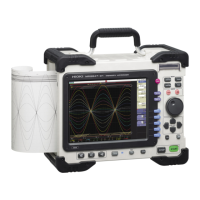7.2 Specifying a Waveform Range (A/B Cursor)
105
7
Chapter 7 Waveform Screen Monitoring and Analysis
When the waveform is shown as a time display, the range can be specified with the div cursor or
Trace cursor.
The specified range will be used for file saving, printing, X-Y synthesis, and numerical calculation.
The range selection will be retained also when the waveform display format is changed.
The general procedure is as follows.
1. Set A/B cursors
See: "A/B Cursor Settings" ( p.102)
2. Specify a range
• For file saving:
System screen - [File Save] sheet - [Save Area] item: Select [A-B Wave].
See:"5.2.2 Automatically Saving Waveforms" ( p.69)
"5.2.3 Saving Data Selectively (SAVE Key)" (
p.74)
• For printing:
System screen - [Printer] sheet - [Slct Print Area] item: Select [A-B Wave].
See:"6.2 Making Auto Print Settings" ( p.91)
"6.3 Manual Printing With PRINT key (Selective Printing)" (
p.93)
• For X-Y synthesis:
Status screen - [Status] sheet - [Combo Area] item: Select [A-B Wave].
See:"7.4 Performing Waveform X-Y Synthesis" ( p.108)
• For numerical calculation:
Status screen - [Num Calc] sheet - [Calc Area] item: Select [A-B Wave].
See:"6.2 Making Auto Print Settings" ( p.91)
7.2 Specifying a Waveform Range (A/B Cursor)
Cursor position can be
verified.
A Cursor B Cursor
About reading measurement values and cursor types:
See: "7.1 Reading Measurement Values (Using the A/B Cursors)" ( p.102)
Available range for A/B cursor
The available range depends on the function.
• Memory function: Recorded measurement data for one measurement
• Recorder function: Recorded measurement data for one measurement, or max. 20,000
internally stored divisions before measurement end point

